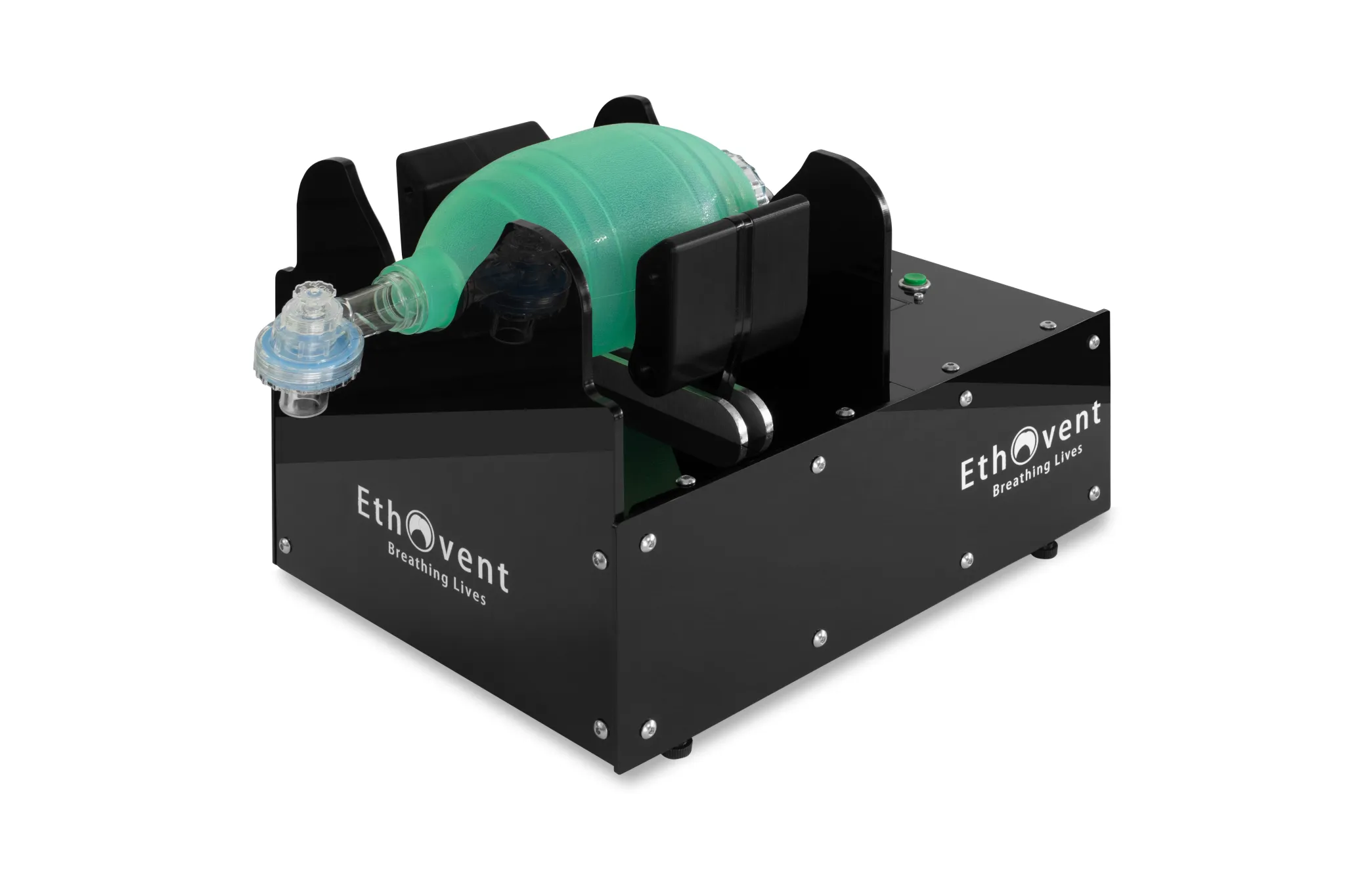[INNOVATION] Ethovent, Malaysia’s First Life-saving Automated Ventilator

by admin

Science Media Centre Malaysia – 27 September 2021
What started out as a fun project for Ganesh Muren during the COVID-19 pandemic has led to the creation of Malaysia’s first-of-its-kind semi-ventilator, Ethovent, an automated bagging machine, to assist patients with breathing difficulties. Ganesh who is Saora Industries’ chief executive officer admitted that being stuck at home during the lockdown gave him an idea to look at opportunities that could also get him out of the house, which means being involved in either healthcare or essential services. As a result, the idea for Ethovent was born two weeks after the first Movement Control Order (MCO) was enforced.
“At the start of the COVID-19 pandemic during the first MCO, we were all under lockdown and to be honest, I was going a bit crazy as we were not used to being stuck at home for a long period of time. When we saw that the government was giving approvals to essential companies, we thought it would be a great idea to work on something along the medical line. So a fun project suddenly turned out to be a real project and a company down the road,” said Ganesh describing the interesting start of their entire journey of the social enterprise.
Over a period of seven weeks, Ganesh and his team at Saora Industries successfully developed Ethovent. As hospitals and medical frontliners grappled with a shortage of ventilators following the increasing number of patients amid the Covid-19 spread, Ganesh saw the opportunity to introduce the technology. Traditionally, a bag valve mask or “Ambu bag” is manually held to ventilate patients. With Ethovent, it mimics the entire movement of a hand squeezing the bag.
“When bagging a patient, it is manually done, usually by a nurse or houseman doctor. However, you are not in control of the pressure, number of cycles or volume of air that goes into the patient. So the bag can ventilate a patient from 50 ml of air up to 800 ml, so there weren’t any monitoring parameters during this process. This is very risky because if you over-bag the patient at high pressure, the lung ruptures. If you under-bag the patient, the lung collapses because there is not enough air,” he said.
 |
| Ethovent underwent successful clinical trials at Tengku Ampuan Rahimah Hospital, Klang and has since garnered interest and positive feedback from several other hospitals. (Photo by Ethovent) |
With Ethovent, doctors are able to monitor the pressure, breathe per minute, and control the volume that goes in by keying inputs into the machine and then the machine bags. The technology also provides an affordable and economical solution for healthcare providers. “The cost of a bag valve mask is about RM500 to RM600, meanwhile ventilators cost about RM50,000 to RM200,000. There is currently no solution in the middle that is able to operate the minimal, but also conducted in a more safe manner. That is why Ethovent was built to utilize the bag, but also have the necessary monitoring parameters that are required by the medical personnel and the American Standard of Anesthesiology. This is a big advantage of our system,” he added.
Creativity vs logic
Interestingly, Ganesh, who is a trained mechanical engineer pointed out that no one from his team had any medical background, however, that did not deter them from thinking out of the box. “None of us are from the biomedical field or medical line. Our team consists of mostly mechanical, electrical and mechatronics engineers. There was a comment that my team used to say, that if we had a biomedical engineer in our team, I don’t think we would have achieved this fast and this much,” he said while adding that they received plenty of negative responses from professionals of the relevant fields.
“Early on, when we spoke to biomedical engineers, it was so demotivating because they kept telling us that our ideas cannot be done, and we will be faced with many issues or it might not be accepted by the market. The comments are always negative but I don’t blame them as they are fixed in a way that tells you this cannot be done,” he lamented. This was a perfect example of how creativity took over logic and enabled Ganesh and his team to think in a novel manner in problem-solving. “None of us had a prior opinion or knew better than the other, so we all discussed everything and tried to find a solution together.”
The sky’s the limit
Ethovent was officially launched in July 2020. Prior to the launch, the semi-ventilator underwent successful clinical trials at Tengku Ampuan Rahimah Hospital, Klang. It has since garnered interest and positive feedback from several other hospitals. Ganesh added that Ethovent entirely replaces the human factor into the whole equation, freeing medical front lines to tend to others and thus increase efficiency. “The hospitals were very keen and said the device could take valuable time off from nurses which enables them to do something else, so it significantly increases the efficiency of the medical personnel in the hospital,” he added.
 |
| Ethovent was launched by then Science, Technology and Innovation (MOSTI) Minister Khairy Jamaluddin Abu Bakar (Photo by Ethovent) |
The team is currently in the process of getting its licence approval from the U.S. Food and Drug Administration (FDA) by the end of this year. After obtaining the FDA certification, Ganesh said, the sky’s the limit: “We have over 3,000 klinik kesihatan in Malaysia and none of them has ventilators as they are too expensive and ventilators that are provided by the Ministry of Health (MOH) can only be operated by consultant doctors, with a minimum of 10 years of experience,” he added while stating that he had received a letter from MOH stating that there are at least 100 medical facilities that would benefit from Ethovent.
“What Ethovent does is it brings down the level of expertise that is needed to use the device – you just need a staff nurse to operate the machine. So this opens up a new dimension of the market to Ethovent that you are able to place in all clinics, hospitals, and even the fire departments. This provides an alternative product innovation to meet urgent calls to escalate the supply of emergency tools and protocols, such as lifesaving ventilators during the COVID-19 pandemic.
A great equaliser for the future of medical technology
Ethovent is one of the pilot projects under the National Technology and Innovation Sandbox (NTIS) funded by the Malaysian Technology Development Corporation (MTDC) which was announced during the Economic Recovery Plan (PENJANA) in June 2020. Having minimal resources readily available during the inception phase, Ganesh believes that Ethovent would not have materialised without the support of the Ministry of Science, Technology and MTDC. “If MTDC did not come on board through NTIS, I sincerely believe that the project would have been dropped, especially due to the lockdown, and it is hard to even go out to meet investors or raise funding. The entire team is very grateful for the NTIS grant,” he said. As a key player in providing a sandbox for new technologies and Malaysian start-ups with a chance to test their solutions in a live environment, NTIS also assists in regulatory assessment processes for its participants to accelerate commercialisation.
 |
| Malaysia’s first-of-its-kind semi-ventilator could also benefit other South East Asian countries as it addresses the gap of locally-produced medical technologies. (Photo by Ethovent) |
Ganesh believes that Ethovent not only has a huge potential in Malaysia, but it could also benefit South East Asian countries as it addresses the gap of locally-produced medical technologies. “In terms of innovation in medical equipment, I think we are far lagging behind, and this was highlighted during the COVID-19 crisis. As you know, most of the technologies are from Western countries which are also very costly. Ventilator manufacturing companies are also selling to the highest bidders. Hence we believe this device is a cost-effective solution and suited for our country and other developing countries,” he said while adding that Ethovent Sdn Bhd is looking at expanding the technology to Indonesia and the Philippines.
“I don’t believe in coincidences. I believe that things have already been sort of pre-planned by the Almighty. This is something that has brought us closer together to work as a team on this project. We started this as a fun project but it is now a life-saving project, and we believe it is our responsibility to complete it,” said Ganesh.





